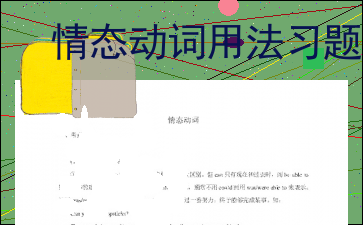情态动词用法习题
以下为《情态动词用法习题》的无排版文字预览,完整格式请下载
下载前请仔细阅读文字预览以及下方图片预览。图片预览是什么样的,下载的文档就是什么样的。
情态动词
一、考点聚焦
情态动词的基本用法
(1)can、be able to 和could
①can和be able to都表示能力,意思上没多大区别。但can只有现在和过去时,而be able to则有更多的形式。但当成功地完成某一具体动作时,通常不用could而用was/were able to来表示。这时was/were able to 相当于managed to,表示经过一番努力,终于能够完成某事。如:
Can you use chopsticks?
The wounded man still was able to get to the village and was saved in the
end.
②can和could
can和could都可以表示能力、技能、许可、建议或请求和可能性。但比较委婉客气地提出问题或陈述看法,一般用could,回答时则用can。如:
Could you help me carry the bag?
Can I help you?
(2)may/might
①may/might表示可能,但may比might可能性大。如:-Why isn’t he in class?
He may be sick.(生病的可能性较大)
—
He might be sick.(生病的可能性较小)
②may/might表示“允许”,may用于现在时或将来时,might常用在间接引语中表过去时,但might也可用于现在时间,表示比较委婉的语气,回答用may。如:
He says we may leave.
He said we might leave.
③may / might 表示建议或请求,但might比may?更客气,意思更肯定而无过去时态的含义。
Yes, you can / may.
—May / Might I use your bike? —
No, you mustn’t
(3)must
①must表示必须,应该,没有时态变化。如:
You must do everything as I do.
②must表示肯定的推测。如:
The light is still on, so he must be at home.
③mustn’t 表示禁止做某事。如:
You mustn’t smoke in the office.
(4)have to
have to 表示“必须、不得不”,是由于某种外界(客观)原因而“必须”,“不得不”做某事,也可表示经常的或习惯性的事“必须”做。have to的否定形式表示不必。have to可用于多种时态中。如:
You will have to clean your own boots when you join the army.
I have to be at my office every evening.
(5)should / ought to
①should和ought to表示应当、应该,前者比后者语气轻。如:
You should / ought to work hard.
②should / ought to work hard.
Since she is not here, whe should / ought to be in the classroom.
③should / ought to的否定 内容过长,仅展示头部和尾部部分文字预览,全文请查看图片预览。 C.I needn’t D.I won’t
解析:答案为B。本题考查表示请求的英语口语,用will来向第二人称提问的疑问结构,是表示一种请求和意愿,是用疑问的形式来表达较为婉转的祈使语气,意思是“请你……,好吗”,对于这种问句的肯定回答是:Suree! Gertainly! Yes, of course. I’d be glad to 等;否定回答通常是:I’m sorry, I can’t. No, I’m afraid I can’t. I’m sorry, but … I’d like to, but …等。注意情态动词表客气的用法及其在一般疑问句中的问与答。
[文章尾部最后300字内容到此结束,中间部分内容请查看底下的图片预览]
以上为《情态动词用法习题》的无排版文字预览,完整格式请下载
下载前请仔细阅读上面文字预览以及下方图片预览。图片预览是什么样的,下载的文档就是什么样的。
图片预览





